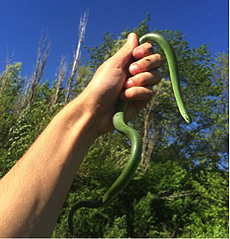Why are there so many species?
 |
| A very uncommon resident at Fermilab, this smooth green snake was observed at Fermilab this spring. Photograph and left arm are courtesy of Tristan Schramer, former Fermilab Natural Areas wildlife monitor currently working as a summer student at Roads and Grounds. |
There are almost a half million species of vertebrates and flowering plants in the world. Add to that almost a million insect species, and one begins to wonder just where they all are. In fact, the vast majority of species are rare by any measure. A survey of nearly any ecosystem will uncover a few common, dominant species and many, many additional species that are represented by less than 1 percent of the total number of individuals. Considering ecosystems as functional systems, it is reasonable to ask how these rare organisms function.
One approach, of course, would be to deny the assumption that ecological systems are functional at all and that assemblages of living things are in large part random. That would require that natural selection keep "cranking out" new species without any ecological constraints on them, which flies in the face of what we know about how natural selection works.
Biodiversity is a cornerstone of ecology and, more importantly, of conservation ecology. Land managers strive for biodiversity, following the rule that more species are better. But a number of theoretical studies have shown that ecosystems with low diversity are just as stable as highly diverse ones. So what ecological good are uncommon species?
Rare, but special? Some species are known as keystone species because they exert a disproportionate effect on the entire ecosystem. Many predators can be thought of in this way, because they serve to limit the numbers of plant-eaters. At Fermilab a relatively small number of coyotes may have an important role in controlling mice, groundhogs — even geese! Uncommon animals also alter the physical environment, creating new habitats. Again at Fermilab, beavers' engineering and construction of dams and ponds is an example.
Waiting in the wings. The notion that systems with low diversity are stable assumes that ecological conditions are stable as well. Obviously that is not always the case. Natural phenomena such as forest fires, floods and volcanic action have profound effects on previously stable environments. Some species, especially plants, are well known as colonizers. They are able to quickly colonize newly available and often harsh environments to begin rebuilding a new ecosystem. They may have very little function in a stable system and yet be the saviors after ecological trauma.
Strength in numbers. Because all species are constrained by genetics, having a high level of genetic diversity, which requires more species, can exploit the environment in more ways. In the prairie, there are a small number of species that are nitrogen-fixing, while most are not. That allows a more efficient nutrient cycling than a small number of species that all use nutrients in the same way.
From a management perspective, then, one must presume that all species in a system are potentially important. Their value may not be obvious or even evident in the short term, but a number of scenarios suggest great ecological potential.
—Rod Walton
|